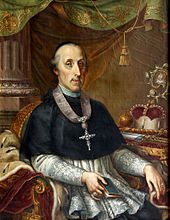Karl Franz von Lodron
Karl Franz von Lodron (born November 18, 1748 in Innsbruck , † August 10, 1828 in Brixen ) was Prince-Bishop of Brixen .
Life
The bishop came from the old north Italian or Tyrolean noble family of the Counts of Lodron , he was the son of Joseph Nikolaus von Lodron and Maria Josepha Walburga nee. Countess Fugger von Kirchberg and Glött . After studying theology, he was ordained a priest on December 21, 1771 . After 20 years of service in the church, Karl Franz von Lodron was appointed Bishop of Brixen on August 16, 1791 ; on March 25, 1792 he received the episcopal ordination from Chur Bishop Dionys von Rost . As shepherd of Brixen, he was also Prince-Bishop, as he had to administer a secular domain in addition to his ecclesiastical diocese.
After the second coalition war , which Austria lost against France , Emperor Franz was forced to sign a peace treaty with France. Brixen had been occupied by the French since 1797 and Karl Franz von Lodron was in exile in Innsbruck.
With the conclusion of the Peace Treaty of Lunéville , Lodron was able to return to Brixen and continued his office from February 9, 1801. As a result of the Lunéville Peace, it was stipulated in the 1803 Reichsdeputationshauptschluss that many bishops should lose their secular dominion. This also applied to the Bishop of Brixen, whose secular territory came to Austria ( secularization ). Although he and his successors continued to hold the honorary title of Prince-Bishop, they actually weren't, as they no longer had any temporal rulership.
From now on Karl Franz von Lodron was only Bishop of Brixen and as such cared more about the religious and the arts. Lodron made a name for itself primarily through the construction and renovation of numerous churches in the Eisack Valley .
His special passion was nativity scenes . Important artists such as Franz Xaver Nißl as well as Alois and Josef Benedikt Probst produced an extensive Christmas and Lenten nativity scene with landscape backdrops and carved wooden figures on his behalf in the Brixen Hofburg . The exhibition shows the salvation history of Jesus and is still considered to be one of the most vivid and artistically valuable nativity scenes in the world.
Bishop Lodron did his best to promote the reputation of the city of Brixen; moreover he was very charitable. In 1971, Hans Hochenegg wrote in his book Der Adel im Leben Tirols that all of Lodron's income went to poor people as well as needy students and artists; he was "charitable to the point of impoverishment". For example, his scholarship enabled Philipp Fallmerayer to study and to support Christian Josef Tschuggmall as a mechanic and inventor.
The brother of the bishop, Franz Josef Graf Lodron Laterano (1745-1791) was, 1790-91 governor of Tyrol.
Legend
There are numerous legends about the person of Lodron. So it should z. B. have happened that near Brixen, during his flight from the French to Innsbruck, a lamb the Episcopal ring swallowed Lodron. Luck in misfortune, because when some French soldiers approached, Karl Franz von Lodron could no longer be identified as Prince-Bishop and he was able to flee unnoticed. On his return to Brixen, to his surprise, he was invited to dinner by a farmer. The latter served him a roast lamb and solemnly handed him the bishop's ring that his lamb had swallowed. As the legend tells, only with the help of the ring could von Lodron lay claim to his former office again.
literature
- Constantin von Wurzbach : Lodron, Franz Karl Graf von . In: Biographisches Lexikon des Kaiserthums Oesterreich . 15th part. Imperial-Royal Court and State Printing Office, Vienna 1866, p. 382 f. ( Digitized version ).
- Erwin Gatz (ed.): The bishops of the German-speaking countries 1785/1803 to 1945. A biographical lexicon. Duncker & Humblot, Berlin 1983, ISBN 3-428-05447-4 .
Web links
- Entry on Karl Franz von Lodron on catholic-hierarchy.org ; accessed on July 15, 2016.
Individual evidence
- ↑ Pierre Surchat: Dionys of rust. In: Historical Lexicon of Switzerland . June 26, 2012 , accessed June 8, 2019 .
- ↑ To the Brixen cribs commissioned by the bishop ( Memento from May 16, 2011 in the Internet Archive )
- ↑ Hans Hochenegg: The nobility in the life of Tyrol. 1971, excerpt from Google book search
- ↑ The legend of the swallowed bishop's ring
| predecessor | Office | successor |
|---|---|---|
| Joseph von Spaur |
Prince-Bishop of Brixen 1791 - 1828 |
Bernhard Galura |
| personal data | |
|---|---|
| SURNAME | Lodron, Karl Franz von |
| BRIEF DESCRIPTION | Prince-Bishop of Brixen |
| DATE OF BIRTH | November 18, 1748 |
| PLACE OF BIRTH | innsbruck |
| DATE OF DEATH | August 10, 1828 |
| Place of death | Brixen |


